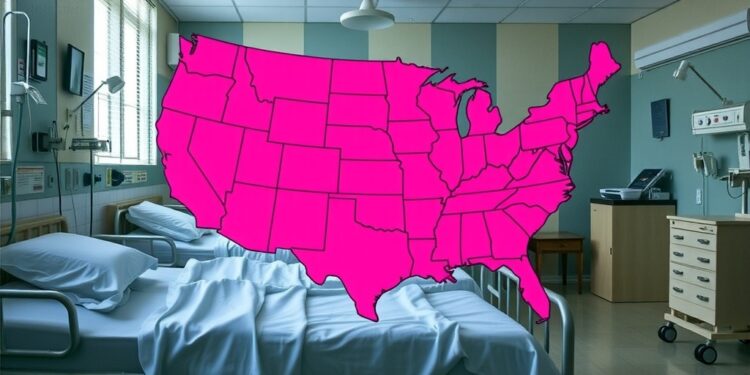
U.S. Hospital Occupancy Rates Signal Potential Crisis as Bed Shortages Loom
As the dust settles from the peak of the Covid-19 pandemic, a pressing concern emerges in the U.S. healthcare system: hospital occupancy rates have surged to levels unseen prior to the health crisis. The dramatic increase in average hospital occupancy—now calculated at approximately 75%—represents a staggering 11 percentage points higher than the pre-pandemic average of 64%. This shift sets the stage for a potential hospital bed crisis by as early as 2032, according to recent findings from UCLA researchers published in the peer-reviewed journal JAMA Network Open.
The ramifications of these findings are alarming. Dr. Richard Leuchter, an assistant professor of medicine at the David Geffen School of Medicine at UCLA and the study’s lead investigator, emphasizes that the current state of hospital occupancy mirrors the extreme demands faced during the Covid-19 pandemic. With the health crisis becoming a distant memory, the fact that hospitals remain as full, if not fuller, raises profound concerns about the sustainability of U.S. healthcare infrastructure.
Utilizing data from the Centers for Disease Control and Prevention (CDC) Covid-19 tracking dashboards, the researchers analyzed hospital occupancy metrics from nearly every U.S. hospital over a period extending from August 2020 to April 2024. The analysis yielded eye-opening insights, revealing that the increased occupancy level is largely attributed to a 16% decline in the availability of staffed hospital beds, while hospitalizations have remained largely stable. This discrepancy underscores a persistent issue within healthcare— an alarming reduction in hospital bed capacity, likely fueled by staff shortages particularly involving registered nurses and the closure of hospitals, occasionally linked to private equity firms’ practices.
The balance of hospital occupancy is delicate. A national average occupancy of 75% threatens to eliminate the buffer needed to accommodate regular fluctuations in patient needs, seasonal surges, and unforeseen spikes in hospital admissions. Dr. Leuchter points out the chilling reality that when ICU occupancy surpasses 75%, significant consequences follow, including an estimated 12,000 excess deaths occurring just two weeks later. Such statistics underscore the critical need for vigilance as hospitals face unprecedented ER wait times and potential lapses in care.
Looking forward, the modeling conducted by the UCLA researchers outlines a dire scenario: if current trends persist unchanged, national hospital occupancy could soar to 85% by 2032. This threshold poses severe risks, as many healthcare professionals believe that general hospital bed shortages become imminent when occupancy hits 85%. The ramifications of enduring high occupancy rates are stark; they could lead to longer emergency department wait times, increased medication errors, and a rise in in-hospital adverse events, potentially culminating in hundreds of thousands of additional deaths annually.
To avoid this impending healthcare crisis, immediate actions are necessary. Preventing further hospital bankruptcies and closures is paramount, entailing an overhaul of hospital reimbursement practices and curbing excessive private equity involvement in healthcare. Factors fueling the staffing exodus, such as provider burnout, must also be addressed to ensure that healthcare systems have adequate personnel. Legislative actions are critical in shaping policies that can enhance the workforce pipeline and enable the recruitment of much-needed healthcare professionals.
A particularly contentious point highlighted by Dr. Leuchter is the recent decision made by the U.S. State Department to freeze new visas for international nurses. This move, viewed as potentially catastrophic, may exacerbate staffing shortages and derail efforts to bolster capacity within the U.S. healthcare system. The ripple effects of such policy decisions could have long-lasting repercussions on healthcare delivery across the nation as providers struggle to maintain quality care amid workforce limitations.
On a more innovative note, reimagining care delivery models could ease pressures on hospitals by reducing the need for hospitalizations altogether. Programs like the Next Day Clinic, initiated at Olive View-UCLA Medical Center within the Los Angeles County Department of Health Services, have demonstrated success in diverting patients from hospitalization. By adopting alternative care models that focus on outpatient treatment, hospitals can effectively manage the influx of patients and cater to the needs of those who require acute care without the necessity of a hospital stay.
The study spans contributions from several co-authors from UCLA, including Dr. Benjo Delarmente, Dr. Yusuke Tsugawa, Sitaram Vangala, and Dr. Catherine Sarkisian, MD. Their collective efforts underscore a multifaceted approach to understanding the interplay between healthcare staffing shortages and hospital occupancy trends. The study is underpinned by substantial funding from various national health institutes, highlighting the urgency and significance of the research.
As U.S. healthcare braces for an uncertain future, the findings serve as a wake-up call. Policymakers must heed these warnings and adopt comprehensive strategies to stabilize hospital occupancy rates, maintain quality care, and safeguard against looming crises. Without proactive measures and innovative approaches, the nation risks facing profound challenges in healthcare delivery and patient outcomes.
In conclusion, the trajectory of U.S. hospital occupancy rates after the Covid-19 pandemic poses significant ethical and operational dilemmas that the health sector cannot afford to ignore. Considerable work lies ahead in fostering resilient healthcare structures capable of not just surviving, but thriving amid changing conditions and increasing demands.
Subject of Research: Health Care Staffing Shortages and Potential National Hospital Bed Shortage
Article Title: U.S. Hospital Occupancy Rates Signal Potential Crisis as Bed Shortages Loom
News Publication Date: 19-Feb-2025
Web References: JAMA Network Open
References: National Heart, Lung, and Blood Institute, National Institute on Aging, NIH/National Center for Advancing Translational Sciences (NCATS), National Institute on Minority Health and Health Disparities
Image Credits: N/A
Keywords: Health care, hospital occupancy, staffing shortages, hospital bed crisis, Covid-19, healthcare policy, emergency care, innovation in healthcare, aging populations, public health.
Tags: Covid-19 pandemic impact on healthcareDr. Richard Leuchter insightsfuture healthcare infrastructure concernshealthcare sustainability issueshospital bed shortage crisishospital occupancy rates trendsimplications of high occupancy ratesincreasing hospital capacity demandsJAMA Network Open publication insightsprojected healthcare shortages by 2032U.S. healthcare system challengesUCLA research findings on hospitals





